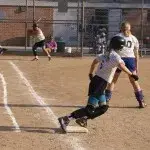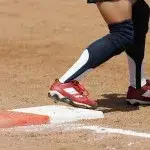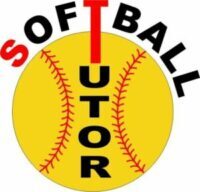
How do we score runs? We start with basic softball baserunning. This skill seems so easy but there are may little intricacies that can have new players confused on what to do. Efficiency and speed are the keys to successful baserunning, which come from training, practice and knowledge of the game. Knowing ones own abilities will also have a huge impact on success on the base path. Missing the base, not tagging up, and not running through first are just a few things that happen regularly for new players.
Things that effect Basic Softball Baserunning
- skill level and experience of the player
- number of outs
- weather the ball is fielded in the air or on the ground
- number of bases occupied and which ones
- skill level and experience of the defense
How often have we seen constant stealing of bases in games where the athletes are new and inexperienced. It makes sense for the players because they know that they will be safe as the catcher likely can not throw all the way to second base and most times not accurately to third. I believe that in those instances, we should be eliminating stealing until the catchers can throw to the bases to promote hitting and playing of the game. With most innings having a limit of 5 runs per inning, it could be over after 5 batters theoretically and no one actually learns or gets to have game experience because all of the runs were basically stolen in rather than hit in. Number of outs should have an effect on baserunning. If there are 2 out for example then the baserunner will need to be more cautious about stealing but needs to go if the ball is on the ground and she is in a force situation.
Number of bases occupied and which ones
This can be one of the most difficult things for a baserunner to learn if they are new to the game. A runner on first must go if the ball is hit and not caught in the air because they must vacate the base for the runner coming from home plate. They don’t have to run if the batter/runner is out due to a fly ball because the batter is out when the ball is caught and the force at first is over. When a runner is on second base and there is no runner on first base then the runner does not have to run to third unless the coach signals because there is no runner on the base behind her that needs to advance to second base. The same is true for third base occupancy. This might be a way to explain it to the players but with smaller words that they can understand.
Whether the ball is fielded on the ground or in the air
This concept is also hard for players to remember. A good way to teach them is to have them all at a base (first, second and third) and the the coach tosses a ball in the air to a fielder. The players on each base react to the fly ball by stepping away from the base with the distance depending on which side of the field the fly ball is and how shallow the ball is. Then they react to the ball depending on how it is fielded. They get back to the base if it is caught and go to the next one if it is not. It is a very fast way for them to learn. I use it a lot when I am teaching or doing clinics for players. third base is a little different.
What I do for new players is have the runner get back to the base when they know it is a fly ball. Because they are then facing home plate in a ready position to go I am their eyes for them. I watch the ball and if it is not fielded I say yes and if it is caught I either say yes or no depending on the depth of the ball. This gives the runner an extra advantage because they don’t have to get back and then go if the ball is caught. When they are experienced at baserunning from third I might have them make that decision. One thing you want to make sure is that you do not use the words go and no. They sound to similar and can cause errors.
The lead off
Getting called out for leading off the base before the pitcher releases the ball happens most often when the baserunner cannot see the ball leave the pitchers hand. It is even more difficult to see the ball leave her hand from second base because the runner is behind the pitcher. The runner almost has to wait an extra second when they think the ball has left the pitchers hand before leaving the base. It is a matter of timing and focusing on the ball. Also knowing the pitcher will help because some work faster than others.
The Track Start

The track start is one that is used often. It is exactly as it says, the same start that track and field athletes use to start a race. The advantage of this start is that the front foot is already ahead and pointing in the direction of the next base and the back foot can push off the base on the start. The disadvantage is that it is easier to lead off using this start because the only part of the foot contacting the base is the heel, so any movement forward can bring the heel off the base and the runner will then be technically leading off. Another disadvantage is that the runner is going from a complete stop which makes it harder to get the momentum into full speed going to the next base.
The Rolling Start
 This start is becoming more popular as athletes and coaches are find that it is easier to get the momentum required to get to full speed going to the next base, because the runner is “rolling” into the take off. The weight begins on the back foot, and as the pitcher is pitching, the runner times the take of with the release of the pitch as their weight transfers to the front foot and they push off the base to the next one. This start is also less likely to cause a lead off because the weight is behind the base and it does not get to the front foot until it is ready to push off to the next one. Try out the two types of lead off and see which one you find most effective. Have a coach or a player simulate a pitcher in the pitching circle with the ball so that the baserunners can practice their timing for taking off from the base.
This start is becoming more popular as athletes and coaches are find that it is easier to get the momentum required to get to full speed going to the next base, because the runner is “rolling” into the take off. The weight begins on the back foot, and as the pitcher is pitching, the runner times the take of with the release of the pitch as their weight transfers to the front foot and they push off the base to the next one. This start is also less likely to cause a lead off because the weight is behind the base and it does not get to the front foot until it is ready to push off to the next one. Try out the two types of lead off and see which one you find most effective. Have a coach or a player simulate a pitcher in the pitching circle with the ball so that the baserunners can practice their timing for taking off from the base.
Stealing
Stealing is one of the most effective ways to advance to the next base if you are fast and the defense is not able to defend your speed effectively. The most important thing for stealing I believe, is that once the decision is made, the runner must go hard until they reach the next base unless they see the ball in front of them. My motto on this one has always been, “she who hesitates is out” meaning that as soon as you doubt or question your ability to advance you will likely be thrown out because you will have slowed down or even stopped at some point during the execution. If the coach gives the signal however, it doesn’t matter what the runner thinks her speed or ability to advance is, she must go. If she is thrown out this is called yes…. a coaches error because we overestimated the potential for opportunity. The ability to slide is also important to success in this skill. Without it, baserunners will have less opportunity to avoid being tagged and may even potentially get injured.
Sliding
As I mentioned earlier, sliding is an important and sometimes, as in College ball, required. If the runner does not slide into second base they may be called out if there was an attempt by the defense to make a double play to 1st after the force at first. And often it is also required to slide at home. There are 3 types of slides that you will likely find useful in your softball career.
Bent Leg Slide
In the bent leg slide, you slide in essentially almost on your back with your arms up behind you and one leg tucked underneath the knee area of the leg that touches slides up over the base. It is important on this slide, to have the foot that is going into the base to be slightly elevated so that it does not get jammed as you stop at the base. This would be used when there is no intent to advance or sometimes used to break up a double play.
Pop up Slide
This slide is the same as the bent leg slide, however this time as you reach the base you are pushing your body up from underneath with the bent leg, using momentum as your front leg hits the base, popping up at the base. This slide will allow you to keep going if the defense commits an error.
Fade Away Tag
Mostly used at home plate, this slide will definitely be useful for avoiding a tag as the ball is coming into the catcher. Most catchers will have their glove and body leaning forward toward the thrower as the ball is arriving. A fade away tag will allow you to slide in behind the catcher sliding your hand across the plate. There is also a hook slide however I have rarely seen it used at any level of play. I would think due to the potential for injury and the level of difficulty.
Coaches Signals
Here is another situation where simple is better. At the college level now we see cheat sheets on baserunners and batters because the signals are so complicated and at times change in between innings. You know your team, and what they are capable of taking in with regard to their memory and the symbolic meanings of signals. One thing I will say for sure though is that 8 year old kids are a lot more capable than some give them credit for. Challenge them and include them in creating your signal system. Practice having them watch for the coaches while on base and in between the bases. Practice having them look for you at third base on their way to second and third. Practice having them look for the base coach at first base after hitting the ball. This will go a long way to getting extra bases when you need them. Baserunning is an art. Knowing the speed of your athletes and having them know their own abilities and speed will go a long way in taking advantage of the defense when possible. Good aggressive baserunning can win games. Practice it, learn it and use it as often as you can.
